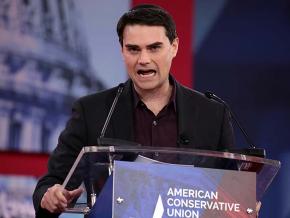Speaking out against an opponent of free speech
and report on a protest against conservative Ben Shapiro and explain the threat he and other conservatives pose to free speech.
ON NOVEMBER 13, some 40 members of the Ohio State University (OSU) community gave conservative commentator Ben Shapiro a “welcome” to campus.
The right-wing campus organization Young Americans for Freedom brought Shapiro, a self-styled conservative intellectual, to speak on the “Big Lie Every Politician Tells You.” This big lie, according to Shapiro, is that the government can intervene in society with positive results.
As usual, Shapiro spent his time attacking social programs like welfare, universal health care and free higher education — and notably little time denouncing rampant military spending, policing and imprisonment that eat up significant chunks of the national budget.
Shapiro is neither a fascist nor a member of the “alt-right” and has been in conflict with these elements since his public resignation from his position as editor-at-large at the right-wing Breitbart News in 2016.

But Shapiro’s brand of conservative intellectualism represents a transition belt for youth into the alt-right. He shares with other right-wing propagandists like Jordan Peterson, Richard Spencer and Milo Yiannopoulos a strategy of building a base on university campuses on the basis of sometimes veiled, often times open, racism, sexism, transphobia, xenophobia and adulation for capitalism.
Before speaking at OSU, Shapiro went to the Ohio legislature to testify in favor of the “Enact Campus Free Speech Act,” a new bill being pushed through the legislature.
While in theory, the bill removes the right to restrict the speech of both right- and left-wing groups, it seeks to ban demonstrations and protests that attempt to shut down or prevent people from attending events — under the notion that such protests are a violation of free speech.
This argument, a favorite of the right on campus, conflates the First Amendment guarantee of free speech from the restriction of the state with the attempts by protesters to make more difficult the expression of far-right and fascist speech.
Ironically, if the “Enact Campus Free Speech Act,” were to pass, it would empower state universities to restrict the right to speech represented by protest. This would pose a significant threat to anti-fascist struggle which has used protest and confrontation as a vital weapon against the growth of the far right.
WHILE SHAPIRO campaigned for restrictions on the right to protest, a protest was being prepared for his event at OSU.
Before November 13, a number of left groups in Columbus came together to plan a demonstration outside of Shapiro’s speaking event, including the Industrial Workers of the World, Democratic Socialists of America, Socialist Alternative, Anti-Racist Action and the International Socialist Organization.
This protest brought out about 40 individuals who rallied across the street before marching into the OSU Student Union, where Shapiro was speaking.
Protesters chanted a number of progressive slogans and attempted to stop the flow of attendees into the event. While some students watching this confrontation joined the rally, a number of Shapiro supporters formed a group to antagonize and “debate” the rally.
Unsure of what they were doing and clearly unprepared to confront the organized protest, Shapiro’s supporters held up posters of Ronald Reagan. This led to some in the crowd to chant “Ronald Reagan is dead” and “John McCain is dead,” which was quickly picked up by right-wing media sites to smear protesters.
While the protest was an important sign of resistance, its weaknesses, too, demonstrate key lessons on how to confront the right.
While protesters mobilized a small crowd of the organized left, to successfully confront the right, we need mass struggles and confrontations which draw out people with an array of views and identities, including liberals, members of cultural and identity-based organizations, unions and those marginalized people who are the explicit targets of the resurgent right.
We should look to the example of the national counterprotests that took place after the massacre at Charlottesville, and the mass demonstrations that prevented fascists from protesting in Boston, Portland and Berkeley.
These examples of mass disavowal of the far right for a time have weakened the transmission belt between the establishment right and the fascist right which the conditions of the Trump presidency have engendered and to which intellectuals like Ben Shapiro contribute.
To stop that belt entirely, we need to expand and deepen the organization on our side to resist every manifestation of oppression.


